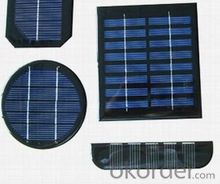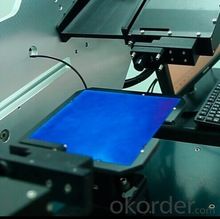High Efficiency Monocrystalline Solar Panel Competitive Price CNBM
- Loading Port:
- Qingdao
- Payment Terms:
- TT OR LC
- Min Order Qty:
- 10 set
- Supply Capability:
- 300000 set/month
OKorder Service Pledge
OKorder Financial Service
You Might Also Like
High Efficiency monocrystalline solar panel competitive price
Quick Details
| Place of Origin: | China (Mainland) | Brand Name: | cnbm | Model Number: | PS-M672300 |
| Material: | Monocrystalline Silicon | Size: | 1956*990*40mm | Number of Cells: | 72 pieces |
| Max. Power: | 300W | Weight: | 23kg monocrystalline solar panel | Product warranty: | 25 years |
| Maximum system voltage: | 1000VDC | Tolerance: | 0/+3% | Cable length: | 1.2m |
| Connector: | MC4 compatible connector | Junction box: | IP65 Rated | Frame: | Anodized aluminium alloy |
| Front Cover: | 3.2mm thick.low iron tempered glass | Cell type: | Monocrystalline solar panel cells 156mm |
Packaging & Delivery
| Packaging Detail: | Monocrystalline solar panel packing information 28pcs. / box 20pcs. / pallet 560 pcs. / 40ft 602 pcs. / 40ft (H) |
| Delivery Detail: | in one week |
Specifications
1. Best monocrystalline solar cell price
2. 300W Monocrystalline solar panel with best price
3. 25 years warranty
Product Description
1.Solar Panel Descprition
PS-M672 Series solar panel is connected in series by 70 pieces of 156mm×156mm Mono Crystalline silicon cells. Solar panel performance is produced according to IEC61215, IEC61730 international standard.
2.Solar Panel Characteristics
1)Manufactured according to international quality and Environment Management
System (ISO9001, ISO14001)
2)High efficiency crystalline silicon solar cells
3)High transmission Iow iron tempered glass, strong mechanical resistance
4)Anti-ageing EVA and excellent anti-climate back sheet
5)Anodized aluminum frame improves load resistance capabilities for heavy wind loads.
6)Standard waterproof junction box
7)High endurance to different weather
8)Good and friendly package with less transportation and storage space.
3.Solar Panel Warranty
1)10 years limited manufacturing warranty
2)10 years for 90% of warranted minimum power
3)25 years for 80% of warranted minimum power
4.Solar Panel Electric Characteristics
| Cell Type | Mono Solar Cell 156mm*156mm | |||
| Item | PS-M672285 | PS-M672290 | PS-M672295 | PS-M672300 |
| Power | 285W | 290W | 295W | 300W |
| Voc(V) | 44.8 | 45 | 45.3 | 345.5 |
| Isc(I) | 8.6 | 8.75 | 8.85 | 8.95 |
| Vm(V) | 36.2 | 36.3 | 36.5 | 36.6 |
| Im(I) | 7.87 | 7.99 | 8.08 | 8.20 |
| Cell Efficiency | 17.08 | 17.38 | 17.68 | 17.98 |
| Module Efficiency | 14.72 | 14.98 | 15.23 | 15.49 |
| Fuse | 15A | |||
| Max System Voltage | 1000VDC | |||
| Cell Number | 72cells | |||
| Tolerance | 0/+3% | |||
| Module Size | 1956*990*40(mm) | |||
| Weight | 23KGS | |||
| Cable Length | 0.9m | |||
| Connector | MC4 or compatible connector | |||



- Q:How do solar panels affect insurance rates?
- Solar panels can potentially lower insurance rates for homeowners. While the installation of solar panels adds value to a property, it also reduces the risk of damage caused by fire, as these panels produce electricity without combustion. As a result, insurance companies may offer discounts or lower premiums due to the reduced risk of fire-related claims. However, it's important to consult with your insurance provider to understand the specific impact on your insurance rates, as policies can vary.
- Q:How much money can you save by using solar panels?
- The amount of money you can save by using solar panels varies depending on several factors, such as the size of the system, your energy consumption, the cost of electricity in your area, and the availability of sunlight. On average, solar panels can save homeowners thousands of dollars over their lifespan, typically between 10-30 years. Additionally, solar panels can reduce or eliminate your monthly electricity bills and can even allow you to earn credits through net metering programs. While the exact amount of savings is difficult to determine without considering specific circumstances, solar panels offer substantial long-term financial benefits.
- Q:How do solar panels interact with the electrical grid?
- Solar panels interact with the electrical grid through a process called net metering. When solar panels generate excess electricity, it is fed back into the grid, and the homeowner or business owner receives credits for the energy they contribute. During times when solar panels do not produce enough electricity, such as at night or on cloudy days, energy is drawn from the grid to meet the demand. This bidirectional flow of electricity allows solar panel owners to offset their energy consumption and reduce their electricity bills.
- Q:what size would the panel be/ I live in the caribbean so plenty of sun!
- What does the advertisement have to do with your question? Yes; BUT, depending on the pump, you may need several panels and possibly an inverter if it is an AC pump. You will ALSO need at least battery in the circuit to provide a load to the panel.
- Q:Can solar panels be installed on streetlights?
- Yes, solar panels can be installed on streetlights. This allows the streetlights to generate their own electricity from sunlight, reducing reliance on the electrical grid and promoting sustainability.
- Q:How do solar panels affect the property's LEED certification?
- Solar panels can have a positive impact on a property's LEED certification by contributing towards earning points in various categories, such as Energy and Atmosphere, Sustainable Sites, and Innovation in Design. By generating clean and renewable energy, solar panels help reduce the property's carbon footprint, increase energy efficiency, and promote sustainability, thus enhancing the property's overall LEED certification.
- Q:If my school was to purchase enough solar panels to run the school off only their power, how much might that cost? (I have a really small school, only 384 kids.)Just general prices of solar panels and how much electricity they yield would be fine too.
- Solar panels typically cost in the range of 8 to 0 dollars per kilowatt of power they are capable of providing. That same kilowatt of power costs in the range of 8 to 0 cents normally. This is the reason solar is not all that viable, without government incentives. The person who responded You're looking at $0,000 to $40,000... is so far off the real answer as to not even be funny. I suspect a solar pv system for a school would start in the $400,000 to $500,000 range. Many areas though have incentives, which will reduce the actual out of pocket costs (but not to $0k).
- Q:how much power is generated with solar panels? also please give me links for that information.and how much would the costs be for this alternative energy source?
- The amount of electrical energy (kWh) a kW grid connected solar PV system will generate on an average day (kWh/kWp.day). There are some factors that will determine just how much electricity you can create with solar panels for your property - The size of the system, the direction that your roof faces and the angle of the roof comes next. For optimum performance, your panels will need to be on a 35-degree angle, facing south.
- Q:A homeowner is considering putting a horizontal solar panel on her roof to heat water for domestic use. An average increase of water temperature each day from 60oF to 20oF is wanted for 50 gallons. How large a panel would be needed on a clear winter day at 40o latitude if the overall efficiency is 50%?
- Here's a typical 4' x 8' collector rating. 40 degree latitude would be a cool climate, so you look at row D, water heating in a cool climate. Probably take the middle rating, mildly sunny day, and it is 0,000BTU per panel per day (it's 9,000 on a sunny day). 38,700 BTU / 0,000 BTU = 3.87, they'd need about 3 to 4 panels. If you used the sunny day number, you'd only need 2, but 3 is more realistic, as it is not always a sunny day.
- Q:Can solar panels be used in developing countries?
- Yes, solar panels can be used in developing countries. In fact, they can be a highly effective and sustainable solution for providing electricity in areas where access to energy is limited. Solar panels are easy to install, require minimal maintenance, and can harness the abundant sunlight available in these regions. Additionally, solar energy can help reduce reliance on expensive and polluting fossil fuels, improve access to electricity for schools, hospitals, and homes, and contribute to the overall development of these countries.
1. Manufacturer Overview |
|
|---|---|
| Location | |
| Year Established | |
| Annual Output Value | |
| Main Markets | |
| Company Certifications | |
2. Manufacturer Certificates |
|
|---|---|
| a) Certification Name | |
| Range | |
| Reference | |
| Validity Period | |
3. Manufacturer Capability |
|
|---|---|
| a)Trade Capacity | |
| Nearest Port | |
| Export Percentage | |
| No.of Employees in Trade Department | |
| Language Spoken: | |
| b)Factory Information | |
| Factory Size: | |
| No. of Production Lines | |
| Contract Manufacturing | |
| Product Price Range | |
Send your message to us
High Efficiency Monocrystalline Solar Panel Competitive Price CNBM
- Loading Port:
- Qingdao
- Payment Terms:
- TT OR LC
- Min Order Qty:
- 10 set
- Supply Capability:
- 300000 set/month
OKorder Service Pledge
OKorder Financial Service
Similar products
New products
Hot products
Hot Searches
Related keywords





























